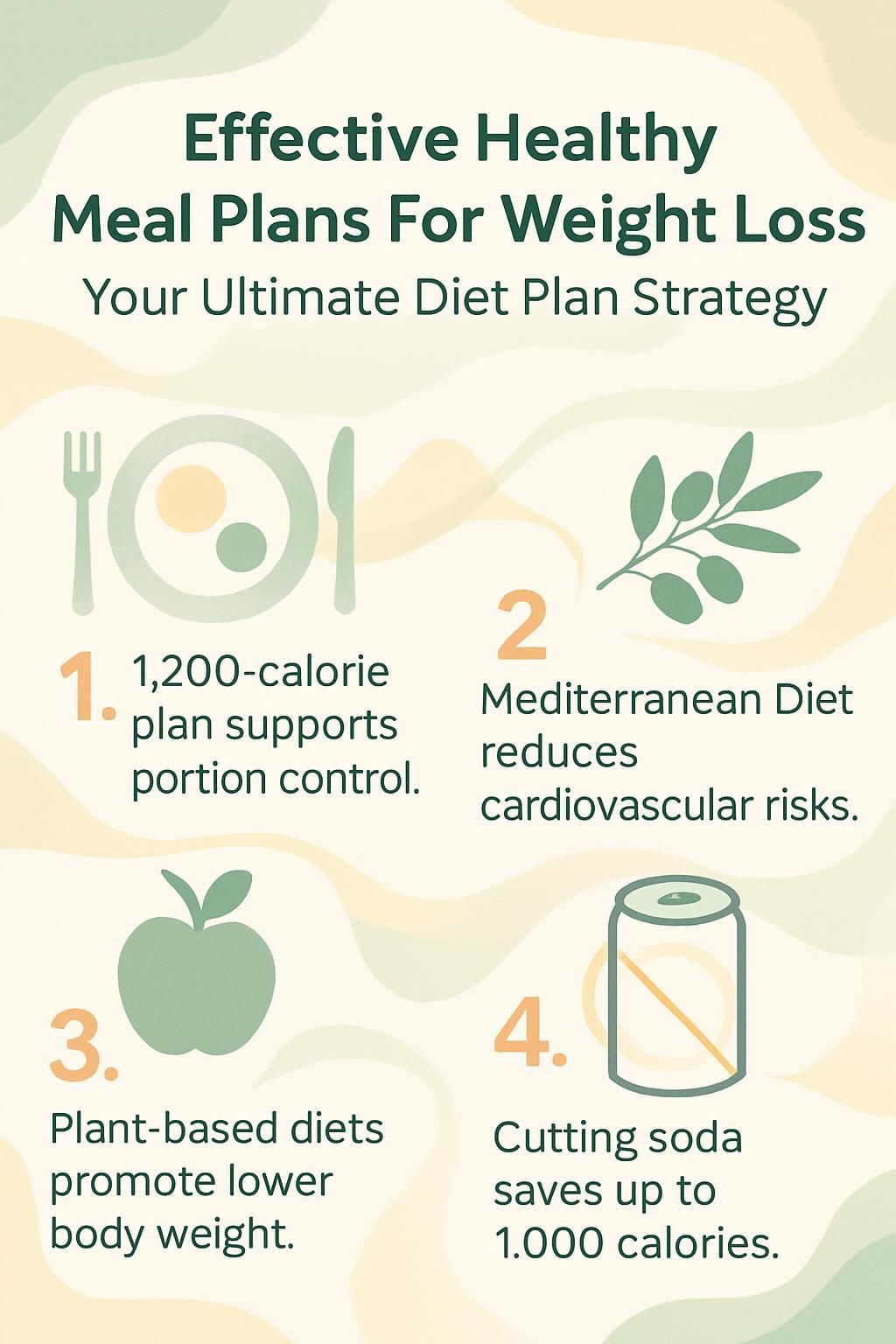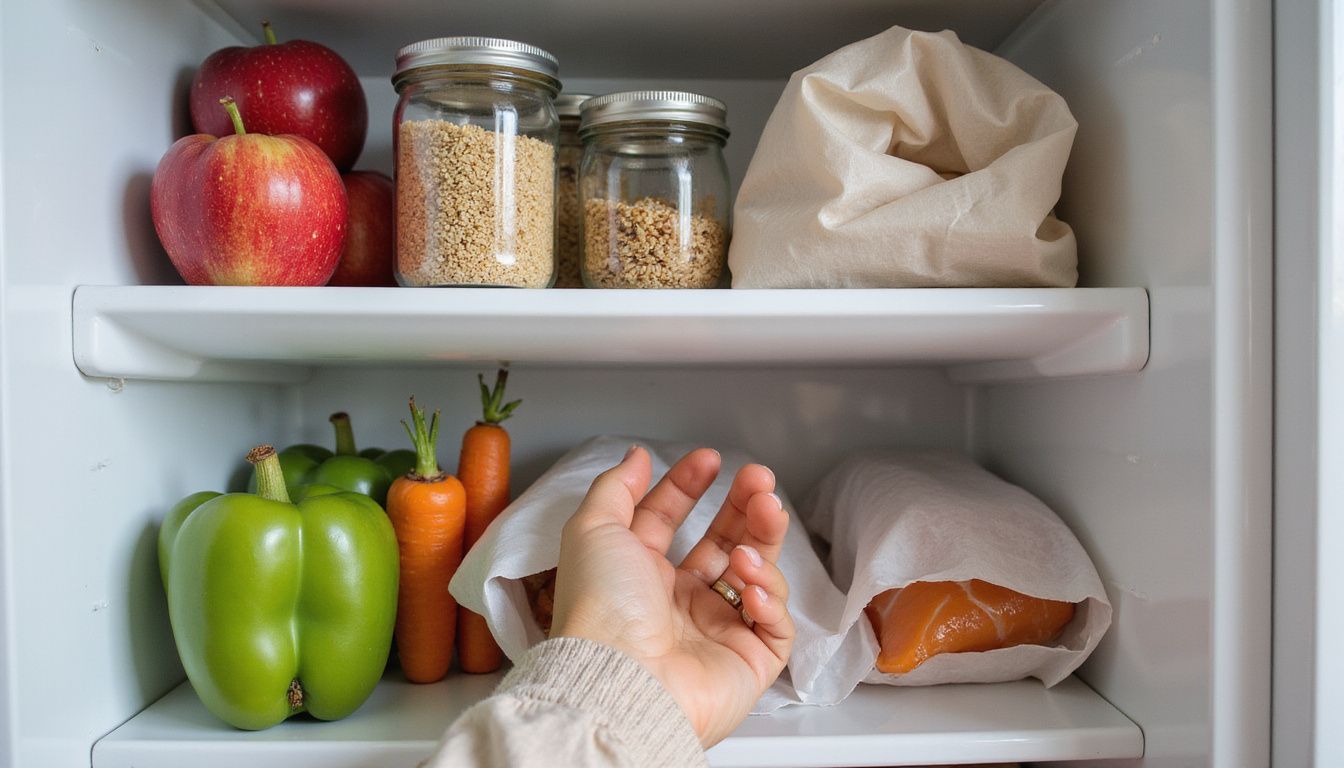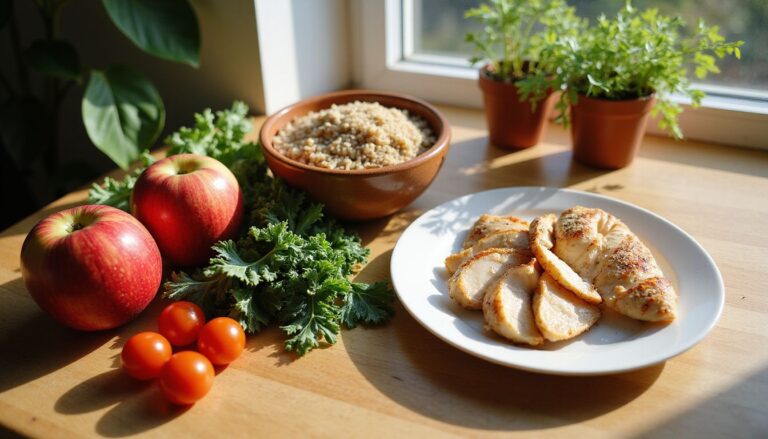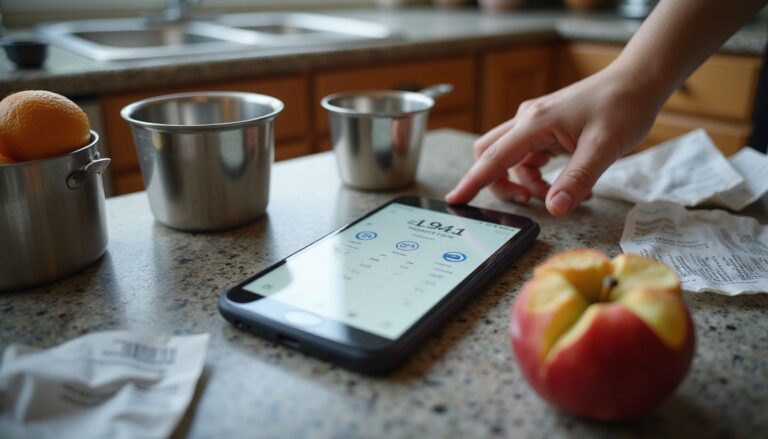Effective Healthy Meal Plans For Weight Loss: Your Ultimate Diet Plan Strategy
Our Nutrition Assistant AI Suite will transform your body. You will lose fat, get toned, and build muscle. Gain confidence and optimal health.
Trying diet after diet without results can wear you down. A clear meal plan gives you structure, helps you cut extra calories, and makes healthy eating feel doable. Research shows planned meals support steady weight-loss and better long-term habits.
This guide walks you through a simple 7-day eating plan. You will learn how to choose whole grains, lean protein, and healthy fats, and how portion control changes the game. Use these steps to shape a balanced diet plan that fits your taste and lifestyle.
Key Takeaways
- Healthy meal plans built on whole grains, lean proteins, and healthy fats support safe weight loss and may reduce the risk of heart disease and high blood pressure (Harvard T.H. Chan School of Public Health).
- Portion control with a 1,200-calorie plan helps manage intake, avoids overeating, and uses high-fiber foods to keep you full.
- The Mediterranean Diet, with daily fruits and vegetables, olive oil as the main fat, fish twice weekly, and limited red meat and processed food, lowers key risk factors for cardiovascular disease.
- Plant-based diets in studies from 2017 to 2021 increased fiber intake and were linked to lower body weight without missing core nutrients (Kahleova et al., Barnard et al.).
- Replacing added sugars and refined grains with nutrient-dense options cuts obesity risk. Limiting sodas can cut about 1,000 calories per week, based on CDC estimates.

Why Are Healthy Meal Plans Important for Weight Loss?

Healthy meal plans give you a daily roadmap. That structure helps you choose better foods and control calories, which supports a healthy weight. You also save mental energy since decisions are made in advance.
Build most meals around nutrient-dense foods. Pick fruits and vegetables, lean proteins like skinless chicken or tuna, whole grains such as brown rice or quinoa, and healthy fats from nuts or olive oil. High-fiber foods and beans help you feel full with fewer calories.
Meal planning is flexible. You can match it to your preferences and needs. A breakfast of Greek yogurt with berries adds protein and antioxidants with little added sugar. Pairing lean protein with fiber-rich foods supports digestion and steadier blood sugar. Replacing processed snacks with hummus, steamed broccoli, or similar choices can lower your risk of heart disease and high blood pressure.
Once you grasp these basics, you can follow a diet plan longer without feeling deprived.
Next, focus on the core principles that drive a strong weight loss diet plan.
Key Principles of a Successful Weight Loss Diet Plan
A smart diet plan blends nutritious foods with clear serving sizes. Small daily changes add up and can reduce your risk for cardiovascular disease.
What Are Whole, Nutrient-Dense Foods?
Nutrient-dense foods deliver vitamins, minerals, and fiber for relatively few calories. Choose items that are unprocessed or minimally processed. These foods provide more nutrition per bite, which helps with fullness and weight control.
Replace refined grains with whole grains like brown rice, oats, or quinoa. Aim for lean proteins, for example grilled chicken breast, omega-3 rich fish such as salmon, tofu, chickpeas, and beans. Fill your plate with colorful produce, including spinach, bell peppers, sweet potatoes, berries, carrots, oranges, cucumbers, tomatoes, and mixed greens. These foods contain antioxidants that may lower the risk of heart disease and some cancers.
High-fiber eating is linked to better digestion and steadier blood sugar. One cup of cooked lentils has about 15 grams of fiber, which is over half the daily value for many adults on a 2,000 calorie eating plan.
“Foods packed with vitamins and minerals help you feel full longer.”
Dr. Michelle Hauser, Stanford University School of Medicine
Plant-forward patterns like the Mediterranean diet highlight vegetables, fruits, whole wheat breads, olive oil, legumes such as lentils, and nuts like almonds and walnuts. This pattern is tied to lower cardiovascular risk.
Sources: Mayo Clinic, Stanford Medicine
How Can Portion Control Aid Weight Loss?
Portion control helps you manage calories without banning favorite foods. Many people find a 1,200 or 1,400-calorie meal plan easier to track. Pre-portion snacks such as unsalted nuts, seeds, fruit, nonfat yogurt, whole-grain crackers, and raw veggies. Smaller plates can also help by making portions look larger.
For example, pre-packing single servings of cottage cheese with berries can curb late-day hunger while keeping calories in check. The Mediterranean pattern offers helpful serving cues, like three fruit servings per day at about half a cup each. Plan meals to match your calorie needs for steady progress.
Why Is Balancing Macronutrients Essential?
Macronutrients are protein, carbohydrates, and fats. Each plays a different role in your body. Eating lean protein at every meal supports muscle, manages hunger, and improves satiety.
Whole grains offer slow-release carbohydrates for steady energy. Healthy fats, including those in olive oil and nuts, support heart and brain health. A balanced plate should also include fruits and vegetables for fiber. This improves digestion and helps you feel full longer. Research suggests 20 to 35 percent of calories from fat, mostly unsaturated sources like olive oil or nuts, may reduce inflammation.
Combining these foods can also help keep blood sugar steady across the day.
How Much Water Should You Drink for Weight Loss?
Hydration supports appetite control and digestive health. Water can help you feel full between meals, which makes it easier to skip calorie-rich drinks like soda or sweet smoothies.
Your water needs vary based on age, activity level, climate, and the foods you eat. Sip water throughout the day rather than waiting for thirst. Keep a bottle nearby during workouts or meal prep. Choose water or other unsweetened drinks, such as plain tea, to avoid extra calories from added sugars.
A Simple 7-Day, 1,200-Calorie Meal Plan
This easy 7-day, 1,200-calorie menu offers straightforward options for breakfast, lunch, and dinner. Use it as a starting point and adjust portions to fit your calorie needs.
What to Eat for Breakfast, Lunch, and Dinner on Day 1
Day 1 uses portion control and whole foods. You will build simple meals with whole grain bread, lean protein, and plenty of produce.
- Have 3/4 cup bran flakes with sliced banana for fiber and steady energy.
- Add 1 cup fat-free milk for protein and calcium with few calories.
- Lunch: fill a mini whole wheat pita with 3 ounces turkey breast, half a roasted pepper, mustard, a light spread of mayonnaise, and lettuce.
- Add one part-skim mozzarella string cheese for extra protein.
- Include two kiwis for antioxidants and vitamin C.
- Dinner: bake or roast 4 ounces of Zesty Lemon-Herb flounder. It is lean and flavorful.
- Cook 1 cup couscous for a simple whole-grain side.
- Steam 1 cup broccoli for fiber, vitamin A, and vitamin C.
- Enjoy one single-serve ice cream for a portioned dessert.
Prepping grain sides like couscous and quick veggies like broccoli keeps weeknight dinners simple and satisfying after a long day.
What to Eat for Breakfast, Lunch, and Dinner on Day 2
Day 2 aims for nutritious meals with simple prep so you can stay consistent.
- Breakfast: blend 1 cup frozen berries, half a banana, and 8 ounces low-fat or fat-free milk for a smoothie. Add one or two hard-boiled eggs for extra protein.
- Lunch: pair 1 cup vegetable soup with a veggie burger on whole-grain toast or an English muffin. Add 1 cup fresh grapes.
- Dinner: serve barbecue cutlets with a light drizzle of barbecue sauce and Dijon mustard. Add orange citrus slaw for crunch and vitamin C, about 265 calories total.
- Swap in sautéed spinach with olive oil, garlic, tomatoes, and onion if you want more vegetables. Add half a plain or sweet potato for fiber.
- Drink water across the day, aiming for about 8 to 10 cups based on your needs.
- Season with vinegar or mustard instead of heavy sauces to limit added sugar and fat.
- Choose snacks like strained yogurt or canned black beans if you need extra protein between meals.
What to Eat for Breakfast, Lunch, and Dinner on Day 3
Day 3 balances whole foods and lean proteins for steady energy and satiety.
- Breakfast: cook 1/2 cup oats in unsweetened soy milk. Add half an apple, 1 teaspoon honey, and cinnamon.
- Lunch: shred 4 ounces roasted skinless chicken. Mix with 1/4 cup red grapes, 1 tablespoon slivered almonds, 1/4 cup chopped celery, 1 tablespoon mayo, and 1 tablespoon Greek yogurt. Serve on leafy greens with one slice multigrain toast.
- Dinner: steam 4 ounces shrimp. Bake a potato and top with 3 tablespoons salsa and 1 tablespoon Greek yogurt. Steam 3 cups spinach for a vitamin-rich side.
- Dessert: pick a 1-ounce chocolate square or an ice cream bar with 100–150 calories.
- Drink at least eight cups of water for hydration and hunger control.
- Cook by baking, steaming, roasting, grilling, or sautéing instead of frying.
- Add soybeans as cooked edamame or a snack for protein and fiber.
What to Eat for Breakfast, Lunch, and Dinner on Day 4
Day 4 keeps it simple and filling with whole foods that support weight loss.
- Breakfast: 1 cup plain or low-sugar Greek yogurt with 1 cup berries.
- Lunch: a sandwich with 1 mini whole-wheat pita, 3 ounces roast beef, tomato, lettuce, and a thin spread of mustard and horseradish. Add 2 cups raw veggies with 1/4 cup hummus.
- Dinner: 4 ounces poached salmon for lean protein and omega-3 fats. Make slaw with 1.25 cups coleslaw mix, 2 sliced scallions, 1 tablespoon rice vinegar, and 1.5 teaspoons olive oil.
- Serve 1 cup cooked quinoa for steady energy and a boost of iron.
- Drink water in place of high-calorie beverages to reduce appetite spikes.
- Many meals include nutrient-dense staples like eggs, oranges, whole-grain toast, maize tortillas, and lean cuts of beef or chicken.
- Meal prep on weekends can save time and support portion control on busy weekdays.
Next, compare popular diet plans so you can choose the way of eating that fits your life.
What to Eat for Breakfast, Lunch, and Dinner on Day 5
Day 5 leans on whole foods that support health and satisfaction.
- Breakfast: 1 cup Cheerios with 1/2 cup fresh berries and 1 tablespoon slivered almonds. Add 6 ounces Greek yogurt for protein.
- Lunch: make mushroom quesadillas in about 25 minutes. Serve with cucumber spears for hydration and fiber.
- Include 1/2 cup cottage cheese or Greek yogurt for extra calcium.
- Pick two clementines for a sweet, low-calorie fruit.
- Dinner: balsamic-glazed pork tenderloin, about 370 calories per serving. This lean protein helps preserve muscle during weight loss.
- Serve with roasted butternut squash for complex carbs and fiber.
- Drink water instead of sugary beverages to support your goals.
- Use mustard instead of mayo to trim calories while keeping flavor.
Following a clear plan like this often leads to better energy and steady progress through the week.
What to Eat for Breakfast, Lunch, and Dinner on Day 6
Day 6 continues with satisfying meals that manage calories and support nutrition.
- Breakfast: 1 frozen whole-grain waffle with 2 tablespoons nut butter and a small sliced banana. Add cinnamon or nutmeg. Drink 8 ounces fat-free milk.
- Lunch: healthy tuna salad with low-fat mayo and nonfat yogurt, about 135 calories per serving. Add 10 baby carrots, two-thirds cup plain Greek yogurt, and a small pear.
- Dinner: serve spicy sausage jambalaya with controlled portions. Sauté 3 cups fresh spinach in garlic with 1 tablespoon olive oil.
- Use mustard as a dip or in tuna salad to avoid high-calorie dressings.
- Snack on berries if needed for fiber and antioxidants.
- Drink at least eight cups of water to support digestion.
- Limit sugary beverages, which add liquid calories fast.
- Focus on lean proteins like tuna to help preserve muscle during calorie cuts.
What to Eat for Breakfast, Lunch, and Dinner on Day 7
Day 7 keeps meals balanced and simple. You will aim for steady energy and fullness.
- Breakfast: half a toasted English muffin with 1 ounce reduced-fat cheese and sliced tomato. Add 1 cup steamed spinach, a poached egg, and one grapefruit.
- Lunch: black bean salad with 1/2 cup black beans and 1/2 cup orange slices. Mix in red bell peppers, onions, scallions, and 1 teaspoon vinegar. Serve over salad greens with one corn tortilla.
- Add sliced fruit or berries for antioxidants and natural sweetness.
- Drink water through the day and aim for at least 8 cups.
- Dinner: choose lean proteins like grilled chicken or tofu with steamed vegetables such as broccoli or carrots. Add a serving of whole grains like brown rice or quinoa.
- Include healthy fats with a drizzle of olive oil or a few avocado slices.
- Limit processed foods. Use herbs and spices to boost flavor without extra calories.
This pattern helps you meet nutrition goals while getting the most from a low-calorie plan. Berries also make easy snacks if you want something between meals.
Popular Weight Loss Diet Plans
Different diet plans use different frameworks, but most successful plans share core habits. Review these options and pick one that fits your routine.
What Is the Mediterranean Diet?
The Mediterranean Diet focuses on plant foods and healthy fats. You eat plenty of vegetables and fruits, beans, lentils, nuts, and whole grains every day. Extra virgin olive oil is the main fat, not butter or lard. Fish like salmon and sardines show up at least twice per week for omega-3 fats.
Red meat appears rarely, often less than 3 ounces per week. Sweets and sugary drinks stay limited. The Mediterranean Diet Pyramid features produce, whole grains, yogurt with berries, salads dressed with olive oil, water or herbal tea, and moderate wine if you already drink alcohol.
For a light after-dinner habit, a simple berry salad with olive oil and lemon can feel fresh and satisfying.
| Food Group | Frequency or Serving |
|---|---|
| Vegetables and Fruits | Daily, build most meals around them |
| Whole Grains | Every day |
| Beans, Lentils, Nuts | Several servings each week |
| Fish | Twice weekly, favor omega-3 sources |
| Red Meat | Less than 1 small serving per week |
| Sweets and Sugary Drinks | Limit or avoid |
| Extra Virgin Olive Oil | Main fat source |
What Is the Mayo Clinic Diet?
The Mayo Clinic Diet focuses on habits you can sustain. You will eat more fruits, vegetables, and whole grains. The plan uses phased steps that guide behavior change, which helps with long-term weight control.
One helpful tactic is to fill half your plate with vegetables at most meals. This simple step can reduce calorie intake without counting every calorie in your diet plan.
Many people like this plan because it builds skills and routines instead of strict rules.
How Do Low-Carb Diets Work?
Low-carb diets limit carbohydrates such as bread, pasta, and sweets. When carbs drop, your body uses more stored fat for energy. This shift is called ketosis. Many people feel less hungry on low-carb plans because protein and fat increase fullness.
You may see rapid progress at first from water loss after cutting carbs. Many readers also report better energy once they reduce sugars and refined grains. Easy swaps, like cauliflower rice for white rice, make this pattern easier to follow.
What Are Plant-Based Diets?
Plant-based diets center on fruits, vegetables, beans, lentils, and nuts. This approach overlaps with Mediterranean eating, which also favors produce and whole foods.
Vegetarian plans exclude meat and fish; you get protein from beans, peas, soy, and nuts. Vegan plans remove all animal products. Many evidence-based resources provide full meal plans for both styles.
Recent studies suggest plant-based patterns can lower body weight while boosting fiber without missing key nutrients. Swapping some meat-heavy dinners for bean chili or lentil soup can be an easy starting step.
Sources: Kahleova H et al., J Geriatr Cardiol. 2017;14(5):328-334. Barnard ND et al., Nutrients. 2019;11(1):12.
What Foods Should You Include in a Healthy Weight Loss Plan?
The right mix of foods makes it easier to lose weight and maintain good health. Aim for lean proteins, whole grains, produce, and healthy fats.
Why Choose Lean Proteins?
Lean proteins help you feel full longer with fewer calories. Try fish up to three times per week, 3 to 4 ounces per serving. Add poultry once a day at about 3 ounces per meal if desired.
Egg yolks can fit in daily, one per day, while egg whites have no set limit and provide pure protein. Low-fat or fat-free dairy supplies calcium and protein with less saturated fat. Aim for one serving of milk, yogurt, or cheese most days. A healthy tuna salad made with low-fat mayo and nonfat yogurt is about 135 calories per serving.
These choices support muscle while you lose weight and can curb between-meal hunger.
How Do Whole Grains Support Weight Loss?
Whole grains such as oats, quinoa, barley, and brown rice provide fiber that improves fullness. High-fiber eating is linked to less hunger and may reduce daily calorie intake by up to 10 percent. Options like bran flakes, whole grain toast, or a mini whole-wheat pita help prevent blood sugar spikes and dips.
Switching from white bread to whole grain bread also delivers more B vitamins and minerals. Studies since 2015 support replacing refined grains with whole grains to aid weight loss. Many meal plans include several servings of whole grains each week.
Fruits and vegetables fill out the rest of your plate and add volume for few calories.
What Fruits and Vegetables Are Best for Weight Loss?
Bananas, apples, berries, kiwis, grapes, clementines, and pears provide fiber with modest calories. They help you stay full and reduce cravings. One medium apple has about 4 grams of fiber and around 95 calories.
Vegetables like broccoli, spinach, Brussels sprouts, zucchini, sweet potato, butternut squash, and coleslaw mix bring vitamins and minerals with low calories. For example, one cup of cooked broccoli has about 55 calories but more than double your daily vitamin C needs. Salads with mixed greens plus avocado or cucumbers make satisfying lunches with little added sugar or fat.
These foods support portion control and better nutrition day after day.
Which Healthy Fats Are Beneficial?
Extra-virgin olive oil is a top choice. Use 1 to 4 servings per day, about 1 tablespoon per serving. Replace animal fats and standard vegetable oils with olive oil to support heart health. Diets rich in monounsaturated fats, found in olive oil, are associated with lower chronic disease risk.
Nuts are another smart pick. Choose raw, unsalted options like walnuts, almonds, or hazelnuts. Aim for at least three servings per week. One serving equals about 1/2 cup whole nuts or 2 tablespoons nut butter. Adding nut butter to breakfast or snacks can improve fullness and help your weight loss meal plan feel more satisfying.
What Foods Should You Avoid for Effective Weight Loss?
Some foods can slow progress on a diet plan. Limiting them protects your results and supports your health.
Why Limit Added Sugars?
High intake of added sugars increases the risk of obesity, diabetes, and heart disease. Desserts, sugary drinks, and many packaged sweets add calories without helpful nutrients. The Mediterranean pattern limits commercial desserts and sweet drinks, allowing small homemade treats a few times per week.
Swap sugary desserts for fruit or nonfat yogurt. If you want chocolate or ice cream, choose a 100 to 150-calorie option. Many people feel more energized after cutting sugary snacks in the afternoon.
What Are the Risks of Processed and Fried Foods?
Processed and fried foods often contain saturated fats, trans fats, and excess sodium. Trans fats increase inflammation and harm blood vessels. The Mediterranean Diet excludes trans fats because they raise cholesterol and cardiovascular risk. CDC data show heart disease remains a leading cause of death in the United States.
Many packaged items contain added salt and preservatives to extend shelf life, which can worsen high blood pressure. For instance, snack chips or fast-food fries can deliver more than half your daily sodium in one serving. Replacing frozen meals with simple homemade options can reduce bloating and daily sodium intake.
Why Avoid Refined Grains?
Refined grains like white bread and white rice lose fiber, vitamins, and minerals during processing. They tend to spike blood sugar and provide fewer nutrients. The Mediterranean Diet limits these foods to protect heart and metabolic health.
Switch to whole grains to improve fullness and manage weight. Research in Nutrients in 2017 linked whole grain swaps to a lower risk of obesity and type 2 diabetes. Many readers find brown rice more filling than white rice at lunch.
How Do High-Calorie Beverages Impact Weight Loss?
Sodas, sweet juices, and alcoholic drinks add calories without reducing hunger. A 12-ounce soda contains about 140 calories. One per day adds nearly 1,000 calories per week, which can stall weight loss.
You can cut calories quickly by choosing water or unsweetened tea. Many people see better progress within weeks after dropping sugary drinks.
How Can You Create a Personalized Meal Plan?
Personalizing your plan helps it fit your life, tastes, and health goals. Use the steps below to shape a plan that works for you.
How to Assess Your Calorie Needs
Your calorie needs depend on age, sex, weight, height, and activity. The Dietary Guidelines for Americans provide ranges from about 1,200 to 2,000 calories for many adults, though some people need more. Many weight loss plans start at 1,200 or 1,500 calories, then adjust based on progress and how you feel.
Use a reputable calculator or talk with a registered dietitian. A short consult can match your plan to your medical history and daily routine. Track energy, hunger, and body changes, then adjust calories or portions as needed.
Why Plan Meals in Advance?
Planning ahead prevents last-minute choices that can derail a diet meal plan. People who plan are more likely to meet nutrition goals and control calories. Batch cooking and using leftovers lowers prep time and helps you avoid processed food.
Advance planning also makes portion sizes more consistent. A weekly schedule can steer you toward whole, nutrient-dense foods rather than fast food.
How to Incorporate Variety in Your Diet
Variety keeps meals interesting and covers more nutrients. Alternate proteins like grilled salmon, tofu, or beans. Add anti-inflammatory choices such as spicy jerk shrimp with pineapple, and antioxidant-rich breakfasts like Bircher Muesli with berries.
Rotate grains through the week, for example brown rice, quinoa, and gluten-free oats. Try different vegetables daily for fiber and vitamins, such as spinach today and roasted sweet potatoes tomorrow. If you need diabetes-friendly recipes, balance carbs like lentils with lean proteins to support steady blood sugar.
How to Use Leftovers Wisely
Store macro-balanced leftovers in airtight containers. Combine brown rice with grilled chicken and steamed vegetables to build quick grain bowls. Brown rice is a gluten-free, dairy-free base that fits most weight loss plans.
Use extra roasted vegetables with cooked grains for the next day’s lunch. Wrap leftover chicken with salad greens for a fast meal on a busy day. These tactics save time and support your nutrition goals.
Cooking double batches of quinoa or lean proteins makes it easy to turn dinners into tomorrow’s salads or stir-fries. The USDA reports that cutting food waste can lower grocery bills by about 20 percent per month. Smart leftovers keep your plan consistent and reduce effort.
Summary:
- Store balanced leftovers for future meals.
- Pair cooked grains with protein and vegetables.
- Repurpose proteins into salads or wraps.
- Reducing waste saves money and supports steady, healthy eating.
How Can You Plan Budget-Friendly Meals for Weight Loss?
Healthy eating does not have to be expensive. Smart shopping and simple recipes protect your budget and your goals.
What Are the Benefits of Buying in Bulk?
Buying in bulk can cut the cost of staples like whole grains, rice, beans, and lentils. These items store well and may cost up to 30 percent less per pound than small packages. Keeping these basics on hand also avoids last-minute store trips.
Bulk buying reduces packaging waste and supports consistent meal prep. Stocking brown rice and lentils makes it easier to prepare balanced meals during the week without running out of ingredients.
Why Choose Seasonal Produce?
Seasonal produce often tastes better, costs less, and carries more nutrients. Spring strawberries are rich in vitamin C. Winter kale can be especially high in antioxidants. Local markets may beat supermarket prices for in-season items.
A 2021 USDA analysis found shoppers saved up to 18 percent by buying locally grown foods in season. Using seasonal produce brings fresh flavor to your menu and helps you stick to your budget.
How Does Cooking at Home Help?
Home cooking gives you control over calories, sodium, and fat. A 2020 USDA survey found homemade meals average about 200 fewer calories than restaurant meals. Cooking your food also helps you choose lean proteins, whole grains, and produce more often.
Measuring portions at home is easier. You can also swap salt for herbs to cut sodium while keeping taste.
What Are the Advantages of Preparing Meals in Batches?
Batch cooking saves time on cooking and cleanup. It also locks in portion control since you divide meals in advance. With meals ready to go, you are less likely to rely on processed foods or high-calorie snacks.
People who plan meals tend to eat healthier and stay within calorie targets more often. Setting aside a few hours on the weekend can set you up for a calmer week.
Source: Drewnowski A, Monsivais P, Maillot M, Darmon N. J Nutr. 2007;137(4):862-865.
What Role Does Physical Activity Play in Weight Loss?
Physical activity burns calories and raises daily energy use. The CDC recommends at least 150 minutes of moderate exercise per week for most adults. Building muscle also increases resting metabolism, so you burn more calories even at rest.
Moderate steps count. Walking after dinner, biking with a friend, or joining a class can boost your motivation. Many people notice lower stress and better sleep after adding regular activity. Pair movement with your weight loss meal plan for steady, sustainable change.
What Common Mistakes Should You Avoid in Weight Loss Meal Plans?
Small missteps can slow progress. Learn the common mistakes below and plan around them.
Why Is Skipping Meals Harmful?
Skipping meals often leads to overeating later. Your body may also slow its metabolism, which means you burn fewer calories. Missing breakfast has been linked with weight gain in some studies, partly due to poor choices later in the day.
Regular meals keep your energy steady and help control cravings. Set a simple rhythm, such as three meals and one snack, and adjust based on hunger and activity.
What Are the Dangers of Relying on Fad Diets?
Fad diets often demand extreme cuts in calories or entire food groups. That can leave you hungry, tired, and short on key nutrients like fiber, healthy fats, vitamins, and minerals. These plans can slow metabolism and make weight regain more likely once the diet ends.
Severe restriction may also affect mood and energy. A 2022 review from Harvard T.H. Chan notes many people regain lost weight within a year after stopping a fad plan. Focusing on whole foods within a balanced diet is safer for long-term results.
Why Is Staying Hydrated Important?
Hydration supports metabolism and appetite control. Water helps your stomach and brain send the right signals about fullness. It also aids digestion and waste removal.
Many people notice fewer headaches and steadier energy when they drink enough water. There is no single rule for everyone. Use thirst and urine color as simple cues, and drink more in heat or during activity.
How Can Underestimating Portion Sizes Affect Results?
Portions can expand without you noticing. Eating 1.5 cups of grains instead of 1 cup adds about 100 extra calories. Repeating that error several times a day can stall progress.
Measure cereal with a cup measure. Use a kitchen scale to learn what 3 ounces of protein looks like. These small habits help you match your plan more closely and see results faster.
Conclusion
Effective healthy meal plans for weight loss give you structure, balanced portions, and a clear path forward. Focus on whole foods, fiber, lean protein, and healthy fats. Drink enough water, plan ahead, and use simple portion tools.
Small, consistent steps lead to steady change. If you have a medical condition or take medication, talk with a registered dietitian or your healthcare provider before you change your diet or exercise plan. Use this 7-day framework to build lasting habits and reach a healthy weight with confidence.
FAQs
1. What makes a meal plan effective for weight loss?
An effective meal plan for weight loss includes balanced portions of lean proteins, whole grains, fruits, and vegetables. It limits added sugars and saturated fats. Studies show that structured plans with calorie control support steady fat reduction and help maintain muscle mass.
2. How can I create a healthy diet strategy that fits my lifestyle?
Start by setting realistic goals based on your daily routine and preferences. Choose nutrient-rich foods you enjoy to increase adherence. Planning meals ahead helps avoid impulsive choices; research suggests this leads to better long-term results.
3. Are there specific foods proven to aid in losing body fat?
Yes, evidence supports the benefits of high-fiber vegetables, legumes like lentils or beans, lean poultry or fish, and whole grains such as brown rice or oats. These foods promote fullness while providing essential nutrients needed during caloric restriction.
4. Can personal experience improve my success with meal planning?
Personal experience plays an important role in building lasting habits; tracking what works helps refine your approach over time. For example, keeping a food journal helped me identify patterns that led to more mindful eating decisions each week.
Summary: Effective healthy meal plans focus on balance and portion control using credible nutrition data as guidance; they adapt to individual needs through practical strategies supported by both scientific evidence and real-life application.







